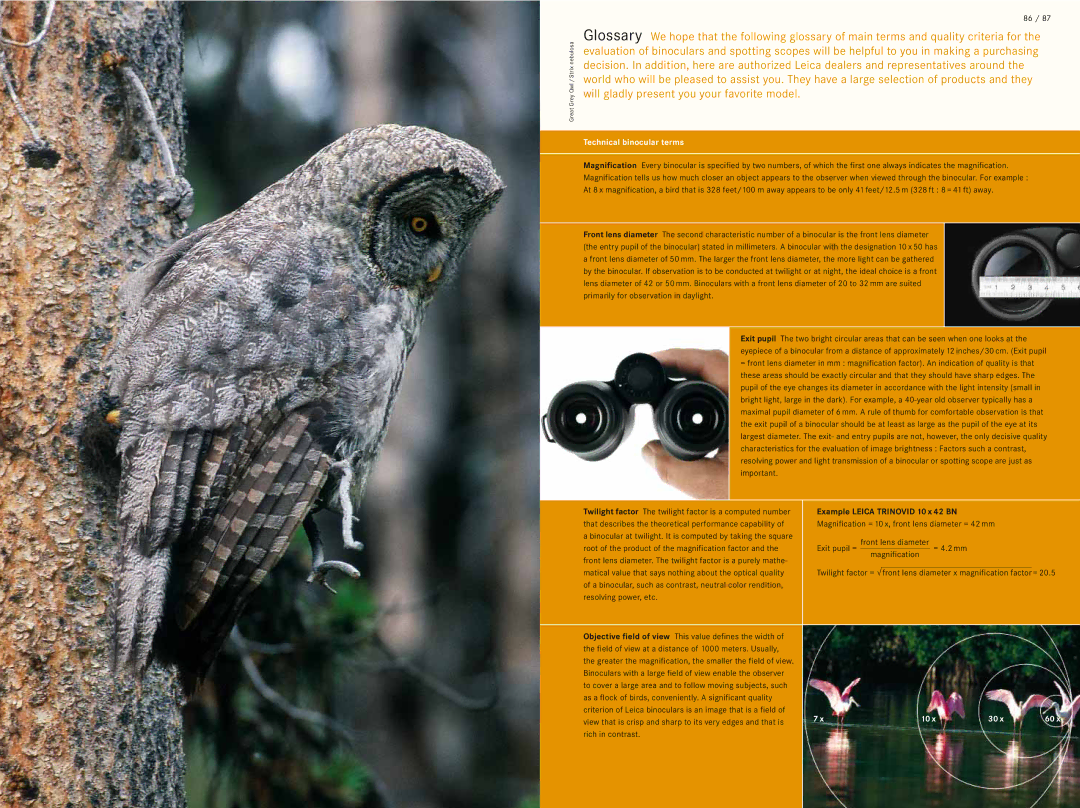
Great Grey Qwl / Strix nebulosa
86 / 87
Glossary We hope that the following glossary of main terms and quality criteria for the evaluation of binoculars and spotting scopes will be helpful to you in making a purchasing decision. In addition, here are authorized Leica dealers and representatives around the world who will be pleased to assist you. They have a large selection of products and they will gladly present you your favorite model.
Technical binocular terms
Magnification Every binocular is specified by two numbers, of which the first one always indicates the magnification. Magnification tells us how much closer an object appears to the observer when viewed through the binocular. For example : At 8 x magnification, a bird that is 328 feet/100 m away appears to be only 41 feet/12.5 m (328 ft : 8 = 41 ft) away.
Front lens diameter The second characteristic number of a binocular is the front lens diameter (the entry pupil of the binocular) stated in millimeters. A binocular with the designation 10 x 50 has a front lens diameter of 50 mm. The larger the front lens diameter, the more light can be gathered by the binocular. If observation is to be conducted at twilight or at night, the ideal choice is a front lens diameter of 42 or 50 mm. Binoculars with a front lens diameter of 20 to 32 mm are suited primarily for observation in daylight.
Exit pupil The two bright circular areas that can be seen when one looks at the eyepiece of a binocular from a distance of approximately 12 inches/30 cm. (Exit pupil
=front lens diameter in mm : magnification factor). An indication of quality is that these areas should be exactly circular and that they should have sharp edges. The pupil of the eye changes its diameter in accordance with the light intensity (small in bright light, large in the dark). For example, a
Twilight factor The twilight factor is a computed number | Example LEICA TRINOVID 10 x 42 BN |
|
| ||||
that describes the theoretical performance capability of | Magnification = 10 x, front lens diameter = 42 mm |
| |||||
a binocular at twilight. It is computed by taking the square |
| front lens diameter |
|
| |||
root of the product of the magnification factor and the |
|
|
| ||||
Exit pupil = |
|
| = 4.2 mm |
|
| ||
|
|
|
| ||||
front lens diameter. The twilight factor is a purely mathe- |
| magnification |
|
| |||
|
|
|
|
|
| ||
matical value that says nothing about the optical quality | Twilight factor = | front lens diameter x magnification factor = 20.5 | |||||
of a binocular, such as contrast, neutral color rendition, |
|
|
|
|
|
| |
resolving power, etc. |
|
|
|
|
|
| |
Objective field of view This value defines the width of |
|
|
|
|
|
| |
|
|
|
|
|
| ||
the field of view at a distance of 1000 meters. Usually, |
|
|
|
|
|
| |
the greater the magnification, the smaller the field of view. |
|
|
|
|
|
| |
Binoculars with a large field of view enable the observer |
|
|
|
|
|
| |
to cover a large area and to follow moving subjects, such |
|
|
|
|
|
| |
as a flock of birds, conveniently. A significant quality |
|
|
|
|
|
| |
criterion of Leica binoculars is an image that is a field of | 7 x | 10 x | 30 x | 60 x | |||
view that is crisp and sharp to its very edges and that is | |||||||
|
|
|
|
|
| ||
rich in contrast. |
|
|
|
|
|
| |
|
|
|
|
|
|
| |
